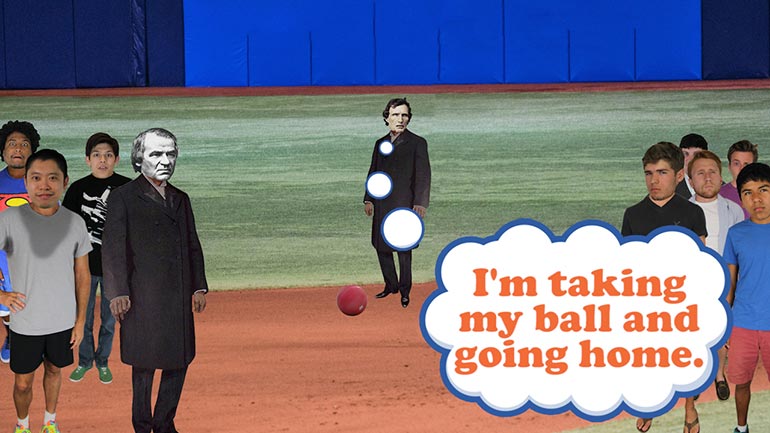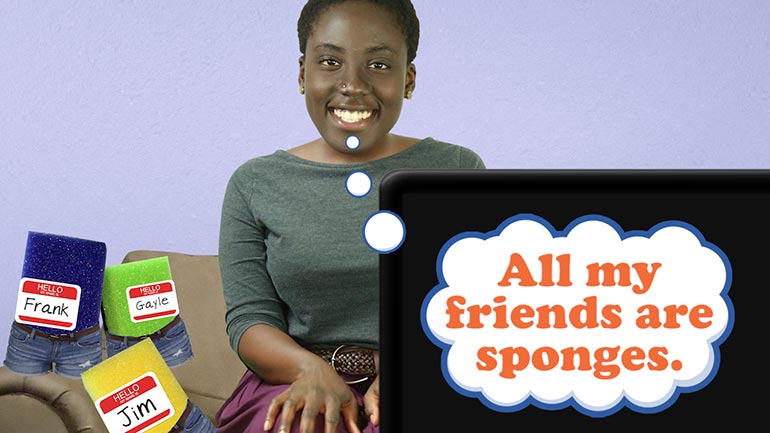ShmoopTube
Where Monty Python meets your 10th grade teacher.
Search Thousands of Shmoop Videos
Science 5: Food Webs 16788 Views
Share It!
Description:
If Spiderman could spin these he'd never be hungry again. Today we're learning all about food webs. Which you actually can't eat, by the way...sorry to get your hopes up.
Transcript
- 00:05
[Dino and Coop singing]
- 00:13
There are two words that you'll hear in your life that are more important and meaningful [Boy with his hands in the air]
- 00:17
than all the other words combined.
- 00:19
“Taco night.”
- 00:20
Those two words truly are magical, aren't they? [Long line of tacos appear]
Full Transcript
- 00:23
Unfortunately, every night is not taco night.
- 00:26
It might be “casserole night” or the dreaded “grandma's weird stew night." [Dino sat next to a bowl of stew with eyeballs in it]
- 00:29
The point we're trying to make here is that your diet is probably pretty diverse.
- 00:33
But, even so, if we were to put all that food into a food web…well, it wouldn't really [Different foods on a spider web]
- 00:37
look all too interesting.
- 00:39
It'd be you on top and all that food below. [Man meditating on a pile of food]
- 00:42
Thankfully, not all food webs are super boring.
- 00:45
But…wait.
- 00:46
Rewind.
- 00:47
What exactly is a food web?
- 00:48
Well, it's simple, really.
- 00:50
A food web is an image we can use to show different food chains, or in other words, [Coop pointing at a blackboard]
- 00:54
who eats what.
- 00:55
A typical food web might look a little something like this: [Spider crawling in its web]
- 00:58
First, we see some plants.
- 01:00
Plants are called “primary producers” because they make their own food using chemistry.
- 01:04
And no, not the kind you learn about in high school. [Plant next to a bunsen burner in a lab]
- 01:06
Unless you happen to sit next to a orchid in your chemistry class…then we stand corrected. [A flash explodes]
- 01:10
And to give credit where credit is due, they don't do it all on their own; they use energy
- 01:15
from the sun to help them out.
- 01:17
Next up come the animals that eat the plants. [Animal on top of the plants]
- 01:19
They're called “primary consumers” because they eat the “primary producers.”
- 01:23
Nice and simple so far, right?
- 01:25
Plants using the sun to make food for themselves, and then animals eating the plants for food. [Guinea pig in a cage]
- 01:30
Unfortunately, life isn't so simple.
- 01:32
Enter our secondary consumers.
- 01:34
These are animals that eat, you guessed it, our primary consumers. [Secondary consumers on top of the primary consumers]
- 01:39
And above them come the tertiary consumers.
- 01:41
All animals that eat other organisms are often referred to as simply “consumers.” [Dino eating a marshmallow]
- 01:46
Connect all those animals together based on who eats what, and we've got ourselves a food web!
- 01:51
And a very scary life for whoever is near the bottom of that pyramid. [Raccoon in a wood]
- 01:54
Maybe don't go outside too much, okay? [Raccoon runs away as the shadow of a bird flies overhead]
- 01:56
Food webs are useful tools to see how ecosystems are connected, as well as to remind us all that
- 02:01
living organisms get their energy from the food they eat or make – no matter how [Coop pointing at a blackboard]
- 02:05
they go about getting it. [Spider making a web]
- 02:06
Another great thing about food webs is that any time there's a human involved, we always
- 02:10
get to be on the very top of it.
- 02:12
For now, anyway.... [Shark jumps over the food pile and eats the guy on top]
Up Next
Check out the best bias video ever made, courtesy of the most awesome and amazing educational website in existence.
Related Videos
No, this isn't a terrible new mint-peach bubble gum flavor...though it does tend to leave a bad taste in people's mouths.
Those settlers in Jamestown really should have settled down with all that land-stealing. Tobacco's bad for you anyway.
Being born out of multiple wars doesn't quite seem to fit the peaceful, polite Canadians we know and love today...oh wait, they were called The Bea...
Not every cartoon is meant to entertain small children while their mother gets some "Mommy time." There are also political cartoons, which are mean...




